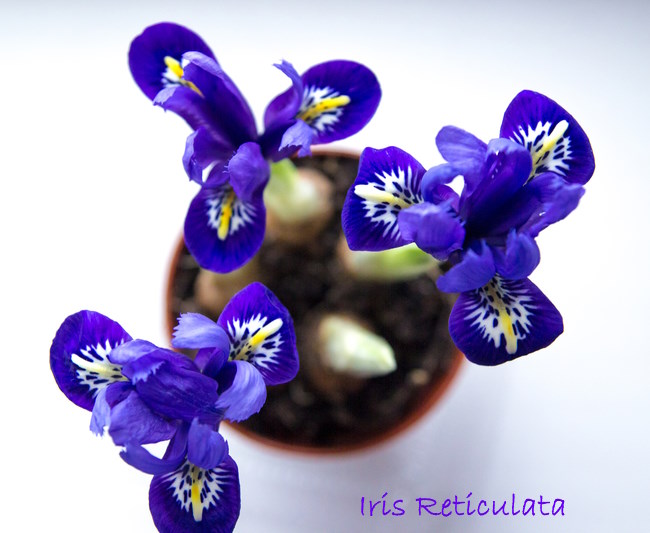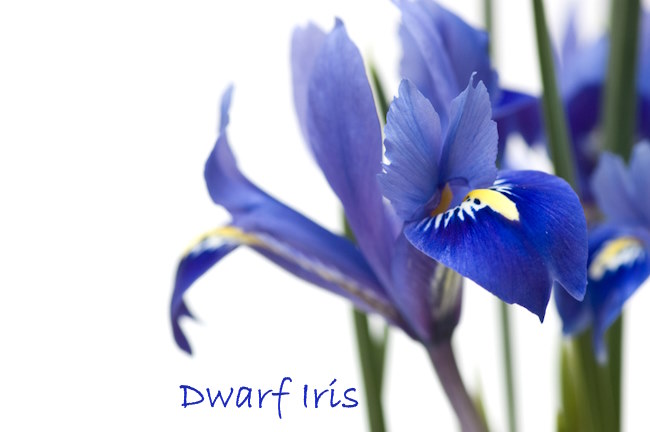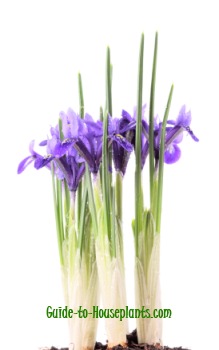Growing Iris Reticulata Indoors
Botanical Name: Iris reticulata
Imagine growing mini irises on your sunny windowsill in the middle of winter. These petite flowers grow from bulbs, not rhizomes as many irises do, and are easy to force indoors in a container.
 'Harmony' is a popular cultivar that makes a gorgeous houseplant. Photo © Pijav4uk
'Harmony' is a popular cultivar that makes a gorgeous houseplant. Photo © Pijav4ukGet to Know Iris Reticulata
All irises are exquisite for their graceful form and symmetry, with 3 inner petals that stand upright and 3 outer petals, called falls.
Iris reticulata 'Harmony' (shown here) is one of the most popular dwarf iris varieties. Although short in stature, those brilliant blooms are gorgeous and sure to win compliments from all who see them.
I think this is among the most captivating flowers you can grow indoors -- or out. And there's more. Those richly colored blooms are also sweetly scented.
 Photo © Vasileva
Photo © VasilevaBuying Tips
Buy iris bulbs that are firm -- not soft or mushy. Don't buy any that are sprouting.
You'll find good-quality iris bulbs for sale at garden centers and online nurseries that specialize in flower bulbs.
Many miniature iris varieties are available to choose from...'Harmony' is one of the most popular in brilliant blue with a golden-yellow lip...'Pixie' has deep violet-blue flowers...'J.S. Dijit' is dark purple...and 'Alida' is a newer cultivar with large flowers and a mid-blue hue.
How to Force Iris Reticulata Bulbs - Step by Step
These mini iris bulbs need a cold treatment for 8 weeks. Start the process in October or November for mid-winter blooms.
- Choose a shallow pot (about 6 in/15 cm deep) with drainage holes in the bottom. Plant iris bulbs 2-3 inches (5-7.5 cm) deep. Go ahead and crowd the bulbs, setting them side by side, pointed end up.
- Water thoroughly and empty drainage saucer.
- Move pot to a dark, cool, but not freezing (35-45°F/2-7°C) location such as a basement, unheated garage or refrigerator. Avoid storing bulbs near ripening fruit or vegetables because the ethylene gas they produce can damage them. Keep them in cold storage for about 8 weeks. Keep the medium barely moist.
- When shoots reach about 2 in (5 cm) tall, bring the pot out of cold storage and place it in a warmer (60°F/16°C) location that gets at least 4 hours of sunlight per day. Give the pot a quarter turn every day for even growth. When in full bloom, keep irises in a sunny location.
Your beautiful Iris reticulata plants should burst into bloom in about 2 weeks. Make them last longer by keeping the flowers as cool as possible -- no warmer than 60°F/16°C. Even with cool temps, your flowers will only last about 5-10 days.
Tips for Growing Iris Reticulata Indoors

Origin: High mountains of Iran and Turkey
Height: 6-10 in (15-25 cm)
Light: Keep in a dark location during cold treatment. Cover pot with a box, pot or black garbage bag if necessary. After shoots appear, move to bright light with some direct sun as directed above.
Water: Water sparingly until growth appears, then water enough to keep soil evenly moist. Soggy soil will cause bulbs to rot.
Humidity: Average room (around 40% relative humidity).
Temperature: After the cold treatment, cool to average 60-65°F/10-18°C. If those temps are too teeth-chattering for you, find a cool windowsill or sun porch.
Soil: All-purpose potting mix
Fertilizer: Feed monthly with a balanced liquid fertilizer diluted by half from planting until start of blooming. Do not fertilize while plants are in bloom.
Propagation: Bulbs. Irises cannot be forced a second time indoors. If you want to keep them, allow the foliage to die back naturally, cut off the stems, then store the bulbs in a cool, dry place. Plant the bulbs in a sunny site with well-drained soil in the fall. Dwarf iris reticulata plants are hardy to Zone 5 and naturally bloom in early spring.

